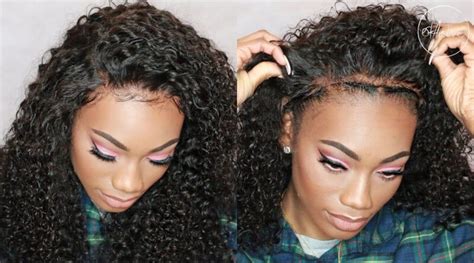Introduction
Wigs have become an increasingly popular fashion accessory, offering versatility, convenience, and the ability to transform one’s appearance instantly. With a wide range of materials, styles, and colors available, there is a wig suitable for every taste and need. This article delves into the fascinating world of wigs, exploring their history, types, benefits, and how to choose and care for them.

A History of Wigs
The history of wigs can be traced back to ancient Egypt, where both men and women wore wigs as a symbol of status and beauty. In the 16th and 17th centuries, wigs became popular among European royalty and the upper classes, serving as a way to conceal thinning hair or display elaborate hairstyles. By the 18th century, wigs had become an essential part of everyday fashion, with both men and women wearing them in various styles. Today, wigs have gained widespread popularity as a form of self-expression and as a way to enhance one’s appearance.
Types of Wigs
There are numerous types of wigs available, each with its unique characteristics and benefits. Some of the most common types include:
- Synthetic Wigs: Made from artificial fibers, these wigs are typically less expensive than human hair wigs and are available in a wide range of colors and styles. They can be heat-resistant, allowing for styling with hot tools.
- Human Hair Wigs: Constructed from real human hair, these wigs offer a more natural look and feel. They are more expensive than synthetic wigs and require more maintenance but provide greater styling versatility.
- Lace Wigs: These wigs feature a lace base that mimics the appearance of a natural scalp. They are often used to create more realistic-looking hairstyles, such as updos and buns.
Benefits of Wearing Wigs
Wigs provide numerous benefits, including:
- Versatile Styling: Wigs allow individuals to experiment with different hairstyles without damaging their natural hair. They can be styled in a variety of ways, from sleek bobs to voluminous curls.
- Protection: Wigs can protect natural hair from damage caused by heat styling, chemical treatments, and environmental factors.
- Privacy: For individuals experiencing hair loss or thinning hair, wigs can provide a discreet way to conceal their condition.
- Convenience: Wigs are easy to put on and remove, allowing for quick and convenient hair transformations.
Choosing and Caring for Wigs
When choosing a wig, it is important to consider factors such as hair type, desired style, and budget. Here are some tips:
- Determine Hair Type: Identify the type of hair you have, whether it is straight, wavy, curly, or coily. This will help you choose a wig with a compatible texture.
- Consider Your Style: Decide on the hairstyle you want to achieve. Wigs are available in a variety of styles, from classic bobs to edgy pixie cuts.
- Set a Budget: Wigs range in price from affordable synthetic options to high-quality human hair wigs. Determine a budget before making a purchase.
Caring for wigs is essential to prolong their lifespan. Here are some tips:
- Regular Washing: Wash synthetic wigs every 6-8 wears and human hair wigs every 10-12 wears. Use lukewarm water and a wig-specific shampoo.
- Conditioning: Condition wigs regularly with a wig-specific conditioner to keep them soft and manageable.
- Styling: When styling wigs, use heat-resistant tools for synthetic wigs and low heat for human hair wigs. Avoid over-brushing or combing.
- Storage: Store wigs on a wig stand or hanger to maintain their shape. Keep them away from direct sunlight and heat.
Human Hair Wigs vs. Synthetic Wigs
There are distinct advantages and disadvantages to both human hair wigs and synthetic wigs:
| Feature | Human Hair Wigs | Synthetic Wigs |
|---|---|---|
| Natural Look and Feel: | Offer a more realistic appearance and feel | Less natural-looking |
| Style Versatility: | Can be cut, colored, and styled with heat tools | Limited styling options |
| Durability: | Last longer with proper care | Less durable, prone to tangling |
| Cost: | More expensive | Less expensive |
| Maintenance: | Require more maintenance, including regular washing and conditioning | Require less maintenance |
Overcoming Pain Points for Wig Wearers
Many wig wearers face common pain points, such as:
- Discomfort: Ill-fitting or poorly made wigs can cause discomfort and irritation.
- Unrealistic Appearance: Wigs that do not blend seamlessly with the wearer’s natural hair or scalp can create an artificial or unnatural look.
- Fear of Damage: Wearing wigs can cause damage to natural hair if not handled properly.
- Limited Styling Options: Some wigs may not offer the desired styling versatility, limiting the wearer’s ability to experiment with different hairstyles.
Effective Strategies for Wig Wearers
To overcome these pain points, wig wearers can adopt effective strategies:
- Choose a Reputable Wig Cap: Invest in a wig cap that fits snugly and comfortably. It should be made of a breathable material to prevent irritation.
- Use Blending Methods: To create a more natural appearance, use hairspray or blending powder to blend the edges of the wig with natural hair.
- Handle with Care: Remove wigs before going to bed and avoid excessive brushing or combing to prevent damage.
- Experiment with Different Wigs: Explore different wig styles and materials to find the ones that offer the desired fit, comfort, and versatility.
